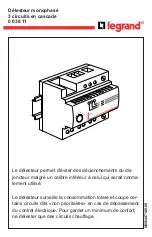
3-4
UR FAMILY – COMMUNICATIONS GUIDE
OVERVIEW
CHAPTER 3: IEC 61850 COMMUNICATION
3
Figure 3-2: ASCI block
The native IED signals (UR settings, FlexLogic operands FlexAnalog operands, and actual values) are assigned to entities
known as Data Attributes (DAs). Data Attributes typically contain the value of a single signal, most often with a Boolean,
Float or Enumerated value. Alternatively a data attribute can have meta-data related to another data attribute, such as
the quality, timestamp, and range of the other attributes. Data attributes have defined names and semantic as defined in
IEC 61850 7-3:2010 clause 8. There are 15 pages of these in the standard, so they are not listed here. A few representative
data attributes are as follows:
•
stVal — Status value of the data
•
setVal — The value of a setting
•
instMag — Magnitude of the instantaneous value of a measured value
•
t — Timestamp of the last change in one of the attribute(s) representing the value of the data or in the q attribute
•
q — Quality of the attribute(s) representing the value of the data
A collection of related data attributes are combined into an entity at the next level up in the hierarchy known as a Data
Object (DO). Data objects are required to be formed in accordance with one of the Common Data Class (CDC) definitions in
IEC 61850 7-3:2010 clause 7. A CDC defines what data attributes an implementing data object is required to contain and
which data objects an implementing data object can optionally contain. CDCs also define the functional constraint (FC) of
each data attribute. An FC is a two-letter code with additional information, such as ST (status information) or SP (setting).
For instance, the Single point status CDC, which is named SPS, requires data attributes stVal, q, and t, and it allows certain
data attributes concerned with the substitution model, value update blocking, and description. The data attribute stVal is
required by the CDC to be a Boolean value, q is required to be a code for the quality of stVal, and t is required to be the time
at which stVal last changed state. Thus an SPS data object contains an amalgamation of information about a Boolean
condition, for instance the thermal alarm status of a thermal overload protection.
In some cases, data objects are constructed from data objects and data attributes. These are known as constructed data
objects. An example is the Phase to ground/neutral related measured values of a three-phase system (WYE) CDC that is
constructed of data objects implementing the Complex measured value (CMV) CDC. The complex measured values here
are the individual phase and neutral phasor value measurements.
A collection of related data objects are combined into an entity at the next level up in the hierarchy known as a Logical
Node. Logical nodes are required to be formed in accordance with one of the individual logical node class specifications in
IEC 61850 7-4:2010 clause 5, as well as conforming to the common logical node class specifications in clause 5.3.3. A
logical node class defines what kind of function an implementing logical node models (its "semantic"), what data objects
















































